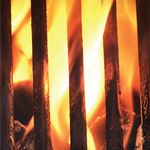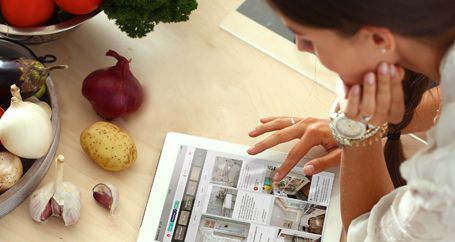"Everything you need — from spices to serving platters — should be within five steps." If they're not, your kitchen isn't laid out correctly."
— Sara Chiarilli, interior designer
Years ago, as a skinny, 23-year-old line cook, Chris Jaeckle spent almost every cent to his name buying a used commercial stove for his apartment at a restaurant supply store on Manhattan’s Bowery. It was $900.
But he was short the $250 delivery fee. So Jaeckle, now the executive chef and founder of an acclaimed made-to-order sushi restaurant in New York City, asked the store to wrap the 480-pound behemoth in plastic. “Then I pushed it all the way home in the bike lane,” says Jaeckle.
As an up-and-coming chef, Jaeckle needed a stove that wouldn’t melt down no matter how hard he tested it. “I used high heat on all burners and kept the oven blasted on 500 degrees,” he says. “I’ve had the range for 14 years now and it still rocks.”
If you’re the kind of cook who daydreams about 22,000 BTU burners and Japanese white-steel knives, researching and designing a kitchen renovation has a certain kid-in-a-candy-store appeal. The challenge? Selecting appliances and kitchen tools with staying power, and avoiding costly bonus features you’ll never use.
That’s why it can make sense to start with a visit to a high-end kitchen showroom, where you can touch, turn and test appliances and hardware. “The appliances are often hooked up to gas, electric and water so you can experience their functionality,” says Tampa Bay, Florida, interior designer Sara Chiarilli.
Before you invest in the next sous vide system, learn more about the features culinary professionals and design experts would add to a devoted cook’s kitchen remodel.
A functional food-prep pattern
Chiarilli watches her clients in the kitchen to assess their movements. Recognizing little details and habits — such as where your most-used tools are located or how much time you spend at the sink — can result in subtle design tweaks that have a bigger impact than brand-new appliances.
To analyze your own pattern, pay attention the next time you cook your go-to weekly meal. “Everything you need — from spices to serving platters — should be within five steps,” says Chiarilli. “If they’re not, your kitchen isn’t laid out correctly.”

1. The ideal “work triangle” connects primary kitchen features. Designing these features in close proximity maximizes efficiency by minimizing the steps between tasks.
2. Kitchen designers recommend at least 36 inches of countertop space on both sides of the refrigerator and stove.
3.The recommended installation height for combination ovens should take into consideration the billowing steam from a hot oven.
Steam and convection combination ovens
These wall-mounted ovens known as “combis,” range in price from $3,000 to $6,000 and deliver a few key features for serious cooks. Because water conducts heat more quickly than air, steam ovens reheat or cook foods fast. Steam cooking also scores health points because the steam prevents foods from drying out, which can reduce the need to use butter or oil to add flavor and moisture. Steam ovens alone do not brown foods, but the added convection feature can roast a chicken to crispy-skin perfection. These wall-mounted ovens known as “combis,” range in price from $3,000 to $6,000 and deliver a few key features for serious cooks. Because water conducts heat more quickly than air, steam ovens reheat or cook foods fast. Steam cooking also scores health points because the steam prevents foods from drying out, which can reduce the need to use butter or oil to add flavor and moisture. Steam ovens alone do not brown foods, but the added convection feature can roast a chicken to crispy-skin perfection.
Buyer pointers:
- Consider installation needs and costs, because combis may require connection to water and drainage pipes.
- Chiarilli recommends using a professional to find the appropriate height for installing these ovens, because steam may billow out when you open the door.
- Steam ovens need to be wiped dry after every use, Chiarilli says. Steam may also cause lime deposit buildup, which means you may have to “descale” the oven with a cleaning solution (similar to cleaning a coffee pot). Always read and follow the manufacturer’s guidelines for cleaning and use.
Countertop space
Why is 36 inches the magic number? “Because you can fit four plates across, a large platter and maybe a cutting board, or you can take out a cookie sheet or baking pan and it fits directly on the counter,” says Chiarilli, who recommends earmarking at least this much space (if possible) on each side of the refrigerator and the stove when you’re reconfiguring your kitchen.
Think of the kitchen as work area — you need clear surfaces next to where you prep food and cook, which is why physical space can be even more useful and valuable than high-end appliances and fixtures. “Many people think they don’t have enough counter space, but I tell them their counters are in the wrong place,” says Chiarilli.
Quartz countertops
Quartz countertops are made from a composite stone (not a single stone slab, like granite) made from crushed quartz mixed with coloring pigments, polymers and resin to make the surface hard and smooth like granite. Although both granite and quartz start at about $80 per square foot, the composition of quartz countertops make them very durable, according to Atlanta designer Megan Harris, who has designed more than 100 kitchens in the last three years. “It’s stain/scratch resistant, and it’s non-porous, which is very important for food prep.”
Buyer pointers:
- If quartz is coarsely ground, countertops will have a flecked surface; finely ground quartz countertops have a more smooth, even look.
- Quartz is designed to be stain resistant, but it can discolor with prolonged exposure to strong sunlight.

Quartz countertops are stain-resistant and non-porous — key features when you’re considering kitchen surface areas for food prep.
Buyer pointers:
- If quartz is coarsely ground, countertops will have a flecked surface; finely ground quartz countertops have a more smooth, even look.
- Quartz is designed to be stain resistant, but it can discolor with prolonged exposure to strong sunlight.

Quartz countertops are stain-resistant and non-porous — key features when you’re considering kitchen surface areas for food prep.
Oven warming drawers
If want to keep your first course warm while you’re finishing the main dish or proof bread while a turkey is roasting, you may want to consider an oven with a warming drawer. This keeps food warm (without overcooking it) by controlling heat and humidity. Once thought of as a high-end kitchen amenity, warming drawers have become a staple for serious cooks.
“Warming drawers — which help with prep and staging — are perfect for someone attempting their trial three-course meal,” says Chiarilli, who also notes the drawers can be used to warm ice-cold dinner plates on the lowest setting. A separate 30-inch electric warming drawer typically retails for less than $1,000.
Buyer pointers:
- High, medium and low settings in a warming drawer can span from 85 to 200 degrees Fahrenheit.
- If you bake often, look for warming drawers with a proof setting between 75 and 90 degrees Fahrenheit, the optimum temperature for proofing.
- Built-in timers on some models can be set to keep food warm for hours. “I bake bread in the morning and when my kids come home from school they can grab a warm roll out of the drawer,” says Chiarilli.
- If you have a smaller kitchen, install a warming drawer in the short end of a kitchen island, which is typically dead space.

Food warming drawers keep food warm without overcooking it by controlling heat and humidity.
Buyer pointers:
- High, medium and low settings in a warming drawer can span from 85 to 200 degrees Fahrenheit.
- If you bake often, look for warming drawers with a proof setting between 75 and 90 degrees Fahrenheit, the optimum temperature for proofing.
- Built-in timers on some models can be set to keep food warm for hours. “I bake bread in the morning and when my kids come home from school they can grab a warm roll out of the drawer,” says Chiarilli.
- If you have a smaller kitchen, install a warming drawer in the short end of a kitchen island, which is typically dead space.

Food warming drawers keep food warm without overcooking it by controlling heat and humidity.
Refrigerator drawers
Discreet, under-counter cooler drawers can create additional countertop space and provide dedicated storage for things like kids’ snacks or craft cocktail bar mixers. “Think of these like a mini-fridge in drawer form,” says Chiarilli. Expect to pay $1,800 for a midrange brand and up to $4,000 for a premium model.
Buyer pointers:
- “Look for models with compartments inside of the drawer,” says Chiarilli, who notes that the best drawers have built-in organization to separate easily bruised peaches from rogue soda cans.
- Generally, drawers should be 30 to 36 inches wide and at least 10 inches high or, ideally, 18-inches high if you plan to store larger bottles or containers.
Single-drawer dishwasher
Think of these pullout dishwashers as a sidekick to your standard dishwasher that can be a perfect fit for a compact kitchen or a pantry, according to Chiarilli. Dishes or cookware stored in the pantry are easier to put away, or if you need to clean only a few dishes, you won’t waste energy or water running a big load. Prices range from around $650 to $1,300, and models with a higher Energy Score may offer extra savings or rebates.
Buyer pointers:
- Consider the location for your dishwasher, because you will have to connect a running water source.
- Before buying a dishwasher drawer, measure your glasses and plates. Most drawer models and standard dishwashers are 24 inches wide, but the typical height clearance for a drawer is 16 inches and accommodates 13-inch plates or stemware.

Measure glasses and plates before buying a single-drawer dishwasher to see if the height clearance (typically 16 inches) accommodates your dishware.
Buyer pointers:
- Consider the location for your dishwasher, because you will have to connect a running water source.
- Before buying a dishwasher drawer, measure your glasses and plates. Most drawer models and standard dishwashers are 24 inches wide, but the typical height clearance for a drawer is 16 inches and accommodates 13-inch plates or stemware.

Measure glasses and plates before buying a single-drawer dishwasher to see if the height clearance (typically 16 inches) accommodates your dishware.
Instant hot-water dispenser
Instead of standard pot-filler faucets, which deliver room temperature water, faucets connected to on-demand hot water units can dispense 160 to 210 degree Fahrenheit water in seconds. Observe your habits before choosing where to install one. “Stand at your sink and consider where you are going to reach,” says Chiarilli. “Mine is on the right. If it was on my left side, I would knock it all the time.”
Buyer pointers:
- Faucets with a generous gooseneck (about $250) allow for filling large pots.
- Consider the design and materials used in the faucet, certain models may be less likely to break down under constant high temperatures.

On-demand hot-water heaters are installed below the sink and can dispense 160 to 210-degree Fahrenheit water in seconds.
Buyer pointers:
- Faucets with a generous gooseneck (about $250) allow for filling large pots.
- Consider the design and materials used in the faucet, certain models may be less likely to break down under constant high temperatures.

On-demand hot-water heaters are installed below the sink and can dispense 160 to 210-degree Fahrenheit water in seconds.
Industrial-strength venting hood
If you’re a cook who likes to sear and sizzle, a serious mid-range exhaust hood costs about $650. “But it’s worth every single penny in terms of reducing smells and smoke,” says The Simply Real Health Cookbook author Sarah Adler.
Invisible storage
Cabinets and drawers designed to de-clutter countertop and floor space make it easier to navigate your kitchen and cook. “We add a lot of slide-out trashcans, drawer stacks, spice pullouts and utility pullouts,” says Harris.
How to calculate a kitchen remodel budget
A simple equation: what is 5 to 15 percent of your home’s total value? That’s the ballpark budget range for a kitchen remodel if you’re seeking a good return on your investment (if and when you decide to sell the home), according to HomeAdvisor.com. Experts warn against choosing high-priced features that outpace the overall value of your home, such as luxury, high-end appliances, if you plan to sell the home within the next five years.
But for foodies spending more than five years in a home, Chiarilli advises them not to skimp. “I see buyer’s remorse when long-term homeowners cut 5 to 10 percent out of their remodel budget,” says Chiarilli. “After a few years, they end up adding those little extras they cut, and at double to triple the cost it would have originally been.”
Renovation Cost
For a kitchen remodel, budget 5 to 15 percent of the home’s total value.

Written by
The information contained in this page is provided for general informational purposes only. The information is provided by Farmers® and while we endeavor to keep the information up to date and correct, we make no representations or warranties of any kind, express or implied, about the completeness, accuracy, reliability, suitability or availability with respect to this article or the information, products, services or related graphics, if any, contained in this article for any purpose. The information is not meant as professional or expert advice, and any reliance you place on such information is therefore strictly at your own risk.
Related articles




